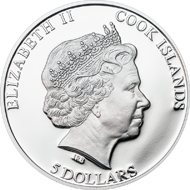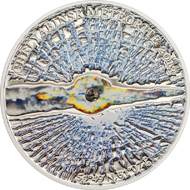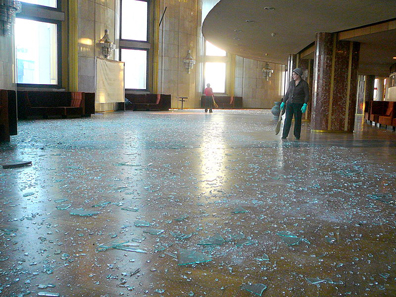September 5, 2013 – On the morning of February 15, 2013, a meteorite hit the earth in the Ural Mountains. This time though, instead of landing a good distance away from populated areas, the enormous celestial body caused considerable damage to the people around the city of Chelyabinsk. Now, a unique coin issued by the Cook Islands allows the viewer to relive this dramatic event.
Cook Islands / 5 Dollars / Silver .925 / 20g / 38.61mm / Mintage: 2,500.
Depicted on the front of the coin is a portrait of the Cook Islands’ official head of state, Queen Elizabeth II. Her name, Elizabeth II appears along the rim, as does the name of the issuing country, Cook Islands, and the nominal value, 5 Dollars.
The reverse of the coin features a coloured image field: A small fragment of the meteorite has been incorporated in the middle, surrounded by a coloured streak of flame running from left to right. Running above and below, from the middle towards the edge, are blue, irregularly broken stripes that represent shattered glass. The words Chelyabinsk Meteorite 2013 appear along the upper edge, and below, the geographic coordinates of the impact point: 54° 49′ N, 61° 07′ E.
Piece of the Chelyabinsk meteorite. Source: Coin Invest Trust.
Meteorites frequently hit earth. These celestial bodies, which are smaller than asteroids (minor planets) but bigger than stardust, have caused immeasurable catastrophes in the past. It is quite likely that it was the impact of a huge meteorite that contributed to a mass extinction approximately 65 million years ago, one which the dinosaurs also fell victim to. Some areas around an impact site teemed with life again after a hundred years – a very short time in the history of the earth perhaps, although not short for us humans. It takes events like the Chelyabinsk Meteorite to really underline just how vulnerable our current complex society really is.
The meteorite. Photo: Alex Alishevskik / http://creativecommons.org/licenses/by-sa/2.0/deed.de.
Around 9:20 am local time, a meteorite hit the earth’s surface near the city of Chelyabinsk in the Urals. Experts also describe it as a bolide, as it shone much brighter than previous meteorites as it entered the earth’s atmosphere. At times, its glow appeared even brighter than the sun! Countless amateur photographers impressively captured the moment. Various measuring institutes contributed to determining the approximate trajectory of the meteorite and its dimensions. The measured inflow velocity of 18 km/s was equivalent to the enormous energy of 100 to 1000 kilotons of TNT. As a comparison, the atomic bomb dropped on Hiroshima released energy of about 13 kilotons. The meteorite would thus have been about 20 metres in diameter and must have weighted about 10,000 tons. At least one fragment of the meteorite broke through the ice cover of Lake Cherbakul, about 80 km outside of town, creating a 6-metre wide hole. But all this doesn’t even begin to touch on the human consequences of this meteorological event.
Many windows were destroyed like in the Chelyabinsk Theatre. Photo: Nikita Plekhanov / http://creativecommons.org/licenses/by-sa/3.0/deed.de
As it entered the atmosphere, the meteorite broke apart, thereby immediately releasing enormous amounts of energy that sent out a powerful shock wave. Shortly after impact, a loud bang was heard. But the shock wave had already done tremendous damage to the entire area. Thousands of buildings were damaged, but even more crucially, thousands upon thousands of glass windows and doors were shattered. Over 1200 people were injured by the flying debris, with many people taken to hospital.
The shock was intense and deep-seated, but fortunately no one was killed. Mind you, in recent history, meteorites have never led to serious damage. The front of the coin depicts how the affected people must have witnessed this unique event on that morning: The viewer looks through a shattered window and sees the meteorite blazing across the sky. As a special feature, each coin contains a small element made from a fragment of the meteorite itself.
More information is available at the website of Coin Invest Trust.
Here you can many numerous images and videos on the meteorite impact.
And scientific background information is provided by NASA.









